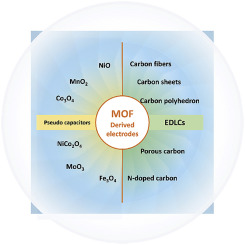Energy Storage Materials ( IF 18.9 ) Pub Date : 2019-12-16 , DOI: 10.1016/j.ensm.2019.12.019 Yu Liu , Xiaomin Xu , Zongping Shao , San Ping Jiang

|
The energy storage field has witnessed a dramatic expansion in terms of short charging time of supercapacitors, especially in the highly active electrode materials. Metal-organic frameworks (MOFs) materials have been extensively applied as precursors or templates for the synthesis of carbon, metal oxides/sulfides-based compounds as high-performance electrodes in supercapacitors. The MOFs-derived materials can be broadly divided into two groups: MOFs-derived porous carbon and MOFs-derived metal oxide/sulfide compounds. These MOFs-derived materials are characterized by unique porous structures, controllable structures, high surface area, good conductivity (MOFs-derived carbon) and outstanding electrochemical stability, meeting the requirements of the desirable specific capacitance and long-term cyclic performance of both electrochemical double layer capacitors and pseudocapacitors. However, MOFs-derived materials still suffer from the complex synthesis process and high production cost of MOFs precursors, difficulties in mass production, and unstable structure in highly corrosive electrolyte. In addition, the electrical conductivity of MOFs-derived metal oxides/sulfides needs to be further improved. In this review, we summarize the recent progresses in the development of MOFs-derived porous carbons and metal oxide/sulfide compounds and their applications in supercapacitors. The prospects and challenges of MOFs-derived carbon and metal oxide/sulfide compounds as highly effective and durable electrodes in supercapacitors are discussed.
中文翻译:

金属有机骨架衍生的用于超级电容器的多孔碳,金属氧化物和金属硫化物基化合物
就超级电容器的短充电时间而言,尤其是在高活性电极材料中,储能领域已经历了巨大的发展。金属有机骨架(MOF)材料已被广泛用作合成碳,金属氧化物/硫化物基化合物的前体或模板,作为超级电容器中的高性能电极。源自MOF的材料可大致分为两类:源自MOF的多孔碳和源自MOF的金属氧化物/硫化物化合物。这些源自MOF的材料的特点是独特的多孔结构,可控的结构,高表面积,良好的电导率(源自MOF的碳)和出色的电化学稳定性,满足电化学双层电容器和伪电容器的理想比电容和长期循环性能的要求。然而,源自MOFs的材料仍然遭受MOFs前体的复杂的合成过程和高的生产成本,大规模生产的困难以及高腐蚀性电解质中结构的不稳定。另外,源自MOFs的金属氧化物/硫化物的电导率需要进一步提高。在这篇综述中,我们总结了MOF衍生的多孔碳和金属氧化物/硫化物化合物的最新进展及其在超级电容器中的应用。讨论了MOF衍生的碳和金属氧化物/硫化物作为超级电容器中高效且耐用的电极的前景和挑战。











































 京公网安备 11010802027423号
京公网安备 11010802027423号